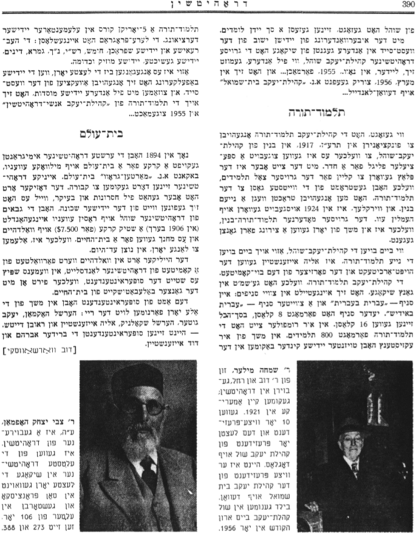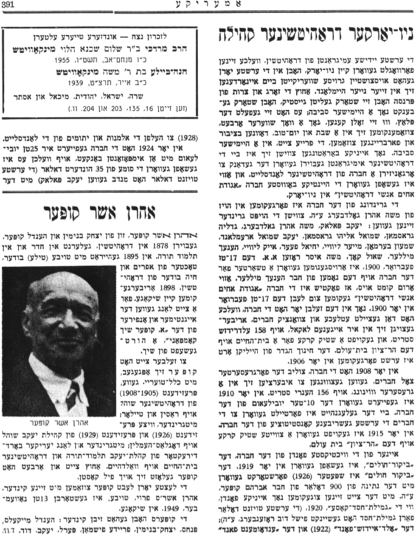Previous Page |
Next Page

[Page 390]
of the rabbi. When the Jewish community moved from the West Side to other areas of Chicago, the great Kehillat Yaakov synagogue, just like many others, had to close. It closed in 1955. In 1956 it reopened as Kehillat Yaakov Beit Shmuel at Devan and Londale.
The Talmud Torah School
As mentioned, the Kehillat Yaakov Talmud Torah school began operations in 1917 in the building of the Kehillat Yaakov synagogue, which contained a special wing for the elementary school. Eventually, however, the place became too small for the large number of students who came from far away streets to the school. Then the community started to think about a new building, which was built in 1924 on Hemlin Avenue. This was the large modern Talmud Torah school that became a jewel for the entire region.
Eliyahu Eisenstein was the chief architect and chairman of the building committee for the construction of both the Kehillat Yaakov Synagogue and the new Talmud Torah school. The Kehillat Yaakov Talmud Torah school, which was renowned throughout Chicago, had two divisions: a division for teaching Hebrew in Hebrew, and another division for teaching Hebrew in Yiddish. Each division had eight classes, for a total of sixteen. At its height, the Talmud Torah had 800 students, and during the period it operated the school saw thousands of Jewish children pass through its doors to receive a five-year education in elementary Jewish education. The educational program included Yiddish and Hebrew, Bible with Rashi's commentary, the Prophets and Writings, Talmud, Jewish law, Jewish history, music, etc.
This continued until fairly recently, when with the move of the Jewish population to the West Side, the Kehillat Yaakov Anshei Drohitchin Talmud Torah school – together with many other Jewish institutions – closed its doors in 1955.
The Cemetery
As early as 1894, the first immigrants from Drohitchin bought land for a cemetery on Milwaukee Avenue to be called the Morton Grove Cemetery. Several émigrés from Drohitchin were buried there. However, there were many problems with this site because it was located far away from the Jewish neighborhood. In approximately 1906, the officers of the Drohitchin synagogue on Racine Avenue bought a parcel of land on Waldheim Street for $7,500 to be dedicated as a cemetery, which is still used today.
The sacred ground on Waldheim is managed by a committee of people originally from Drohitchin, and is headed by a superintendent, who directs all cemetery activities.
Over the years the office of superintendent has been held by: Hershel Hackman, Yaakov Guter, Hershel Skolnick, Eliyahu Eisenstein and Reuven Deutsch, in that order. Today the position is held jointly by Abraham and David Eisenstein.
(Dov Warshavsky)
[right photo:] R. Simcha Miller, son of R. Dov and Rachel Miller. He was born in Drohitchin and arrived in the United States in 1921. For ten years he was the vice-president, and then the last president of the Kehillat Yaakov synagogue on Douglas Street. Today he is the vice-president of the Kehillat Yaakov Beit Shmuel synagogue on Devan Street. This photo was taken at the Kehillat Yaakov Street next to the Holy Ark in 1956.
[left photo:] R. Zvi Yitzchak Hoffman, was born in Drohitchin, and was one of the oldest residents of Drohitchin living in Chicago. In his final years he lived in San Francisco, and died at the age of 106. See pp. 273 and 388.

[Page 391]
THE NEW YORK DROHITCHIN COMMUNITY
The first Jewish immigrants from Drohitchin who arrived in New York experienced great difficulties during their early years in adjusting to their new homeland. In addition to their problems and worries about livelihood, they also suffered emotionally because they missed their homes and the friendships of the old country. They missed having a place where after working hard all week, they could get together on the Sabbath or holidays, pray communally and enjoy each others' company in their free time. After several meetings the Drohitchin immigrants decided to try to organize an association of émigrés from Drohitchin. This resulted in the creation of the well-known association in New York known as the Agudat Achim Anshei Drohitchin.
The organization was started in the home of Moshe Aharon Goldberg. Among the main founders of the organization were: Yaakov Pollack, Moshe Aharon Goldberg, Gedaliah Grossman, Shmuel Eliyahu Grossman, Yaakov Shmuel Aremland, Shimon Berman, Meyer Levy, Yechiel Peer, Ike Levy, Henech Miller, Shaul Koch, Moshe Isser Rosen and others. On February 17, 1900, a charter was issued to the organization in the name of Henech Miller, and the Agudat Achim Anshei Drohitchin thereby came into existence on February 17, 1900. That very same year the organization, which consisted of twenty-some members, moved into its own location at 158 Eldridge Street. In addition, the organization bought a piece of land for burials at the Mount Zion Cemetery, but the dedication of the fence of the sacred site took place only in 1906.
Due to the increase in the Organization's membership, it was forced to move into larger quarters at 156 Henry Street in 1908. In 1910, the Society celebrated its tenth anniversary. At that event, the Society's first written constitution was distributed, and in 1915, a second parcel of land was purchased in the Mount Zion Cemetery.
In 1919 one of the most important funds of the Organization was created – the Medical Assistance Fund. This Fund was enhanced in 1926 by a $900 donation from Abraham Cooper, and eventually other funds were established such as the Free Loan Fund in 1920 (the first one thousand dollars of this fund was contributed by Fishel Dov Rosenberg); the Old Age Fund was established in 1922, and the Endowment Widow and Orphan Assistance Fund was established in 1928.
The Organization celebrated its 25th anniversary in 1924 with an impressive banquet which raised a sum of $3,500. The first thousand dollars was given by Yaakov Pollack with the express purpose of buying for the Organization a home of its own.
[this article continues on p. 392]
[box:] For an eternal memorial to our dear parents
Rabbi Mordechai son of R. Shalom Shachna the Levite Minkovitch
Died on August 14, 1955
Chana Beila, daughter of R. Moshe, Minkovitch
Died on May 8, 1939
Sarah, Yisrael, Yehudit, Michael and Esther
(See pp. 16, 135, 203 and 204. W.)
Aharon Asher Cooper
[photo:] Aharon Asher Cooper
Aharon Asher Cooper, a son of Yitzchak Binyamin and Hendel Cooper, was born in 1878 in Drohitchin. He studied in the kheder school and in the Talmud Torah school. In 1895 he married Toiba (Tila) Buder, a daughter of Ephraim and Chaya Buder of Drohitchin. He moved to Chicago in 1898, and for a long period served as the owner and director of the A. Cooper Shoe Company, a wholesale shoe business.
He was also involved in community activities. He was the president of the Drohitchin synagogue on Racine and Taylor from 1905-1908; he was a co-founder and vice president (1926) and president (1929) of the Kehillat Yaakov synagogue on Douglas and Hemlin; he was a co-founder and longtime member of the board of the Kehillat Yaakov Talmud Torah school and the Drohitchin cemetery on Waldheim Street. In addition to time and work, he covered many expenses.
In his final years, Cooper lived with his children. Aharon Asher's wife, Toiba died on November 13, 1949 in Chicago. The Coopers had seven children: Hendel Michaels, Pinchas, Yitzchak-Binyamin, Frieda Fishman, Perl, Yaakov and David. D.W.
Previous Page |
Next Page
This material is made available by JewishGen, Inc.
and the Yizkor Book Project for the purpose of
fulfilling our
mission of disseminating information about the Holocaust and
destroyed Jewish communities.
This material may not be copied,
sold or bartered without JewishGen, Inc.'s permission. Rights may be
reserved by the copyright holder.
JewishGen, Inc. makes no representations regarding the accuracy of
the translation. The reader may wish to refer to the original material
for verification.
JewishGen is not responsible for inaccuracies or omissions in the original work and cannot rewrite or edit the text to correct inaccuracies and/or omissions.
Our mission is to produce a translation of the original work and we cannot verify the accuracy of statements or alter facts cited.
 Drogichin, Belarus
Drogichin, Belarus
 Yizkor Book Project
Yizkor Book Project
 JewishGen Home Page
JewishGen Home Page
Yizkor Book Director, Lance Ackerfeld
This web page created by Lance Ackerfeld
Copyright © 1999-2025 by JewishGen, Inc.
Updated 19 Dec 2001 by LA


 Drogichin, Belarus
Drogichin, Belarus
 Yizkor Book Project
Yizkor Book Project
 JewishGen Home Page
JewishGen Home Page